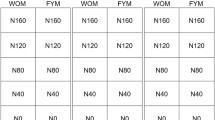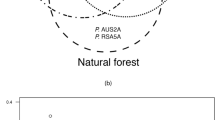Abstract
Background and Aims
Root-associated fungi are known to be important for plant health and nutrition, but only few studies have addressed their diversity in relation to plant health status.
Methods
Fungal diversity in roots of healthy and diseased Pisum sativum plants was examined in terms of barcoded pyrosequencing of the nuclear ribosomal internal transcribed spacer 1. The CLOTU program was used for filtering and clustering of sequences, and Chao 1 estimator was used to calculate fungal richness.
Results
Principal component analyses (PCA) showed that the structure of root-associated fungal communities differed between sites and a clear relationship between root-associated fungal communities and plant health status was found. For example, the arbuscular mycorrhizal (AM) fungus Glomus caledonium was prevalent in roots of healthy plants, whereas the pathogenic fungus Phoma sojicola was prevalent in roots of diseased plants.
Conclusions
The present study revealed clear differences in composition of root-associated fungi from four field sites, and correlations between abundance of several root-associated fungi and plant health status were found.



Similar content being viewed by others
References
Acosta-Martínez V, Dowd S, Sun Y, Allen V (2008) Tag-enhanced pyrosequencing analysis of bacterial diversity in a single soil type as affected by management and land use. Soil Biol Biochem 40:2762–2770
Bellemain E, Carlsen T, Brochmann C, Coissac E, Taberlet P, Kauserud H (2010) ITS as an environmental DNA barcode for fungi: an in silico approach reveals potential PCR biases. BMC Microbiol 10:189
Borowicz VA (2001) Do arbuscular mycorrhizal fungi alter plant-pathogen relations? Ecology 82:3057–3068
Bretag TW, Keane PJ, Price TV (2006) The epidemiology and control of ascochyta blight in field peas: a review. Aust J Agric Res 57:883–902
Buée M, Reich M, Murat C, Morin E, Nilsson RH, Uroz S, Martin F (2009) 454 pyrosequencing analyses of forest soils reveal an unexpectedly high fungal diversity. New Phytol 184:449–456
Bødker L, Kjøller R, Kristensen K (2002) Interactions between indigenous arbuscular mycorrhizal fungi and Aphanomyces euteiches in field-grown pea. Mycorrhiza 12:7–12
Colwell RK (2009) EstimateS: Statistical estimation of species richness and shared species from samples. Version 8.2. User’s Guide and application. http://purl.oclc.org/estimates
Domsch KH, Gams W, Anderson T (2007) Compendium of soil fungi, 2nd edn. IHW Verlag, Eching
EPPO standards (2004) PP 1/172 (2) Bulletin 2:176–178
Filion M, Hamelin RC, Bernier L, St-Arnaud M (2004) Molecular profiling of rhizosphere microbial communities associated with healthy and diseased black spruce (Picea mariana) seedlings grown in a nursery. Appl Environ Microbiol 70:3541–3551
Gardes M, Bruns TD (1993) ITS primers with enhanced specificity for basidiomycetes application to the identification of mycorrhizal and rusts. Mol Ecol 2:113–118
Giovannetti M, Mosse B (1980) An evaluation of techniques for measuring vesicular arbuscular mycorrhizal infection in roots. New Phytol 84:489–500
Gianinazzi S, Gollotte A, Binet MN, van Tuinen D, Redecker D, Wipf D (2010) Agroecology: the key role of arbuscular mycorrhizas in ecosystem services. Mycorrhiza 20:519–530
Irinyi L, Kövics GJ, Sándor E (2009) Taxonomical re-evaluation of Phoma-like soybean pathogenic fungi. Mycol Res 113:249–260
Jumpponen A, Jones KL (2010) Seasonally dynamics of fungal communities in the Querus macrocarpa phyllosphere differ between urban and nonurban environments. New Phytol 186:496–513
Kane RT, Smiley RW (1987) Relative pathogenicity of selected Fusarium species and Microdochium bolleyi to winter wheat in New York. Plant Dis 71:177–181
Kent AD, Triplett EW (2002) Microbial communities and their interactions in soil and rhizosphere ecosystems. Annu Rev Microbiol 56:211–36
Kjøller R, Rosendahl S (1998) Enzymatic activity of the mycelium compared with oospore development during infection of pea roots by Aphanomyces euteiches. Phytopathology 88:992–996
Kjøller R, Rosendahl S (2001) Molecular diversity of glomalean (arbuscular mycorrhizal) fungi determined as distinct Glomus specific DNA sequences from roots of field grown peas. Mycol Res 105:1027–1032
Kormanik PP, McGraw AC (1982) Quantification of vesicular-arbuscular mycorrhiza in plant roots. In: Schenck NC (ed) Methods and principles of mycorrhizal research. American Phytopathological Society, St. Paul, pp 37–45
Kraft JM, Pfleger FL (2001) Compendium of pea diseases and pests. In: Kraft JM, Pfleger FL (eds) American Phytopathological Society. St. Paul, MN, USA
Krüger M, Stockinger H, Krüger C, Schüßler A (2009) DNA-based species level detection of Glomeromycota: one PCR primer set for all arbuscular mycorrhizal fungi. New Phytol 183:212–223
Kövics GJ, de Gruyter J, van der Aa HA (1999) Phoma sojicola comb. nov. and other hyaline-spored coelomucetes pathogenic on soybean. Mycol Res 103:1065–1070
Larsen J, Bødker L (2001) Interactions between pea root-associated fungi examined using signature fatty acids. New Phytol 149:487–493
Lemanczyk G, Sadowski CK (2002) Fungal community and health status of roots of winter wheat cultivated after oats and oats mixed with other crops. BioControl 47:349–361
Letourneau A, Seena S, Marvanová L, Bärlocher F (2010) Potential use of barcoding to identify aquatic hyphomycetes. Fungal Divers 40:51–64
Li S, Hartman GL, Jarvis BB, Tak H (2001) A Stachybotrys chartarum isolate from soybean. Mycopathologia 154:41–49
Monchy S, Sanciu G, Jobard M, Rasconi S, Gerphagnon M, Chabe M, Cian A, Meloni D, Niquil N, Christaki U, Viscogliosi E, Sime-Ngando T (2011) Exploring and quantifying fungal diversity in freshwater lake ecosystems using rDNA cloning/sequencing and SSU tag pyrosequencing. Environ Microbiol 13:1433–1453
Nilsson RH, Abarenkov K, Veldre V, Nylinder S, de Wit P, Broshce S, Alfredsson JF, Ryberg M, Kristiansson E (2010) An open source chimera checker for the fungal ITS region. Mol Ecol Res 10:1076–1081
Öpik M, Metsis M, Daniell TJ, Zobel M, Moora M (2009) Large-scale parallel 454 sequencing reveals host ecological group specificity of arbuscular mycorrhizal fungi in a borenemoral forest. New Phytol 184:424–437
Papavizas GC, Ayers WA (1974) Aphanomyces species and their root diseases in pea and sugarbeet. A review USDA Tech Bull 1485:1–158
Persson L, Bødker L, Larsson-Wikström M (1997) Prevalence and pathogenicity of foot and root rot pathogens of pea in southern Scandinavia. Plant Dis 81:171–174
Quince C, Lanzén A, Curtis TP, Davenport RJ, Hall N, Head IM, Read LF, Sloan W (2009) Accurate determination of microbial diversity from 454 pyrosequencing data. Nat Method 6:639–641
Quince C, Lanzén A, Davenport RJ, Turnbaugh PJ (2011) Removing noise from pyrosequenced amplicons. BMC Bioinformatics 12:38
Selosse MA, Vohnik M, Chauvet E (2008) Out of the rivers: are some aquatic hyphomycetes plant endophytes? New Phytol 178:3–7
Smith SE, Read DJ (2008) Mycorrhizal symbiosis, 3rd edn. Academic, London
Stark C, Babik W, Durka W (2009) Fungi from the roots of the common terrestrial orchid Gymnadenia conopsea. Mycol Res 113:952–959
St-Arnaud M, Vujanovic V (2007) Effect of the arbuscular mycorrhizal symbiosis on plant diseases and pests. In: Hame C, Plenchette C (eds) Mycorrhizae in crop production. Haworth’s Food Products Press, New York
Seifert KA (2009) Progress towards DNA barcoding the fungi. Mol Ecol Resour 9(suppl):83–89
Stockinger H, Krüger M, Schüßler A (2010) DNA barcoding of arbuscular mycorrhizal fungi. New Phytol 187:461–474
Thygesen K, Larsen J, Bødker L (2004) Arbuscular mycorrhizal fungi reduce development of pea root-rot caused by Aphanomyces euteiches using oopores as pathogen inoculum. Eur J Plant Pathol 110:411–419
Unterseher M, Jumpponen A, Öpik M, Tedersoo L, Moora M, Dormann CF, Schnittler M (2011) Species abundance distridutions and richness estimations in fungal metagenomics-lessons learned from community ecology. Mol Ecol 20:275–285
Vandenkoornhuyse P, Baldauf SL, Leyval C, Straczek J, Young JPW (2002) Extensive fungal diversity in plant roots. Science 259:2051
Vandenkoornhuyse P, Maheé S, Ineson P, Staddon P, Ostle N, Cliquet JB (2007) Active root-associated microbes identified by rapid incorporation of plant-derived carbon into RNA. Proc Nat Acad Sci USA 104:16970–16975
Vujanovic V, Hamelin RC, Bernier L, Vujanovic G, St-Arnaud M (2007) Fungal diversity, dominance, and community structure in the Rhizosphere of clonal Picea mariana Plants throughout nursery production chronosequences. Microb Ecol 54:672–684
Wehner J, Antunes PM, Powell JR, Mazukatow J, Rillig MC (2010) Plant pathogen protection by arbuscular mycorrhizas: A role for fungal diversity? Pedobiologia 53:197–201
Whipps JM (2004) Prospects and limitations for mycorrhizas in biocontrol of root pathogens. Can J Bot 82:1198–1227
Wieland G, Neumann R, Backhaus H (2001) Variation of microbial communities in soil, rhizosphere, and rhizoplane in response to crop species, soil type, and crop development. Appl Environ Microbiol 67:5849–5854
Yergeau E, Labour K, Hamel C, Vujanovic V, Nakano-Hylander A, Jeannotte R, St-Arnaud M (2009) Patterns of Fusarium community structure and abundance in relation to spatial, abiotic and biotic factors in soil. FEMS Microbiol Ecol 71:34–42
Acknowledgements
We thank Karsten Malmskov (Ardo A/S), Lihui Xu and Steen Meier for support with field soil sampling and Anne-Pia Larsen and Henriette Nyskjold for their excellent technical laboratory assistance, and Annemarie Fejer Justesen for critical review of the manuscript.
Author information
Authors and Affiliations
Corresponding author
Additional information
Responsible Editor: Erik J. Joner.
Electronic supplementary material
Below is the link to the electronic supplementary material.
Table 1
Supplementary Material_ The list of all 142 OTUs (DOCX 34 kb)
Rights and permissions
About this article
Cite this article
Yu, L., Nicolaisen, M., Larsen, J. et al. Molecular characterization of root-associated fungal communities in relation to health status of Pisum sativum using barcoded pyrosequencing. Plant Soil 357, 395–405 (2012). https://doi.org/10.1007/s11104-012-1180-0
Received:
Accepted:
Published:
Issue Date:
DOI: https://doi.org/10.1007/s11104-012-1180-0




